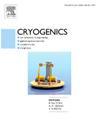在模拟和实验的基础上,研制了80k高比质量单同轴脉冲管制冷机
IF 2.1
3区 工程技术
Q3 PHYSICS, APPLIED
引用次数: 0
摘要
红外探测器是探索宇宙的重要仪器,脉冲管制冷机被广泛用于各种红外探测器的冷却。受空间发射重量限制的严格限制,脉冲管制冷机的高比质量具有相当大的应用潜力。为了获得比质量更高的同轴型脉冲管制冷机,对制冷机减重的关键参数进行了全面分析。采用Sage软件对冷指结构进行仿真和优化。设计了微型冷指,并采用了小型压缩机。高比质量单级同轴脉冲管冷却器的研制已经完成,在80k和102 Hz下,该冷却器的冷却功率为16w。值得注意的是,制冷机的比质量已经提高到3.4 W/kg,这超过了传统10w / 80k制冷机比质量的90%。同时,获得了17.77%的相对卡诺效率。本文章由计算机程序翻译,如有差异,请以英文原文为准。
A single coaxial pulse tube cryocooler with high specific mass operating at 80 K developed based on simulation and experimental methods
Infrared detectors are an essential instrument in the exploration of the universe, and pulse tube cryocoolers are extensively utilized for the cooling of various infrared detectors. Constrained by the stringent restrictions imposed by space launch weight limitations, the high specific mass of the pulse tube cryocooler offers considerable potential for application. In order to obtain a higher specific mass coaxial type pulse tube cryocooler, a comprehensive analysis of the key parameters for the weight reduction of the cryocooler has been carried out. The software Sage was used to simulate and optimize the cold finger structure. A miniature cold finger was designed and a small compressor was used. The development of a high specific mass single-stage coaxial pulse tube cooler has been accomplished, which has been demonstrated to exhibit a cooling power of 16 W at 80 K and 102 Hz. It is noteworthy that the specific mass of the cryocooler has been elevated to 3.4 W/kg, which is in excess of 90 % of the specific mass of a conventional 10 W/80 K cryocooler. Concurrently, a relative Carnot efficiency of 17.77 % has been attained.
求助全文
通过发布文献求助,成功后即可免费获取论文全文。
去求助
来源期刊

Cryogenics
物理-热力学
CiteScore
3.80
自引率
9.50%
发文量
0
审稿时长
2.1 months
期刊介绍:
Cryogenics is the world''s leading journal focusing on all aspects of cryoengineering and cryogenics. Papers published in Cryogenics cover a wide variety of subjects in low temperature engineering and research. Among the areas covered are:
- Applications of superconductivity: magnets, electronics, devices
- Superconductors and their properties
- Properties of materials: metals, alloys, composites, polymers, insulations
- New applications of cryogenic technology to processes, devices, machinery
- Refrigeration and liquefaction technology
- Thermodynamics
- Fluid properties and fluid mechanics
- Heat transfer
- Thermometry and measurement science
- Cryogenics in medicine
- Cryoelectronics
 求助内容:
求助内容: 应助结果提醒方式:
应助结果提醒方式:


